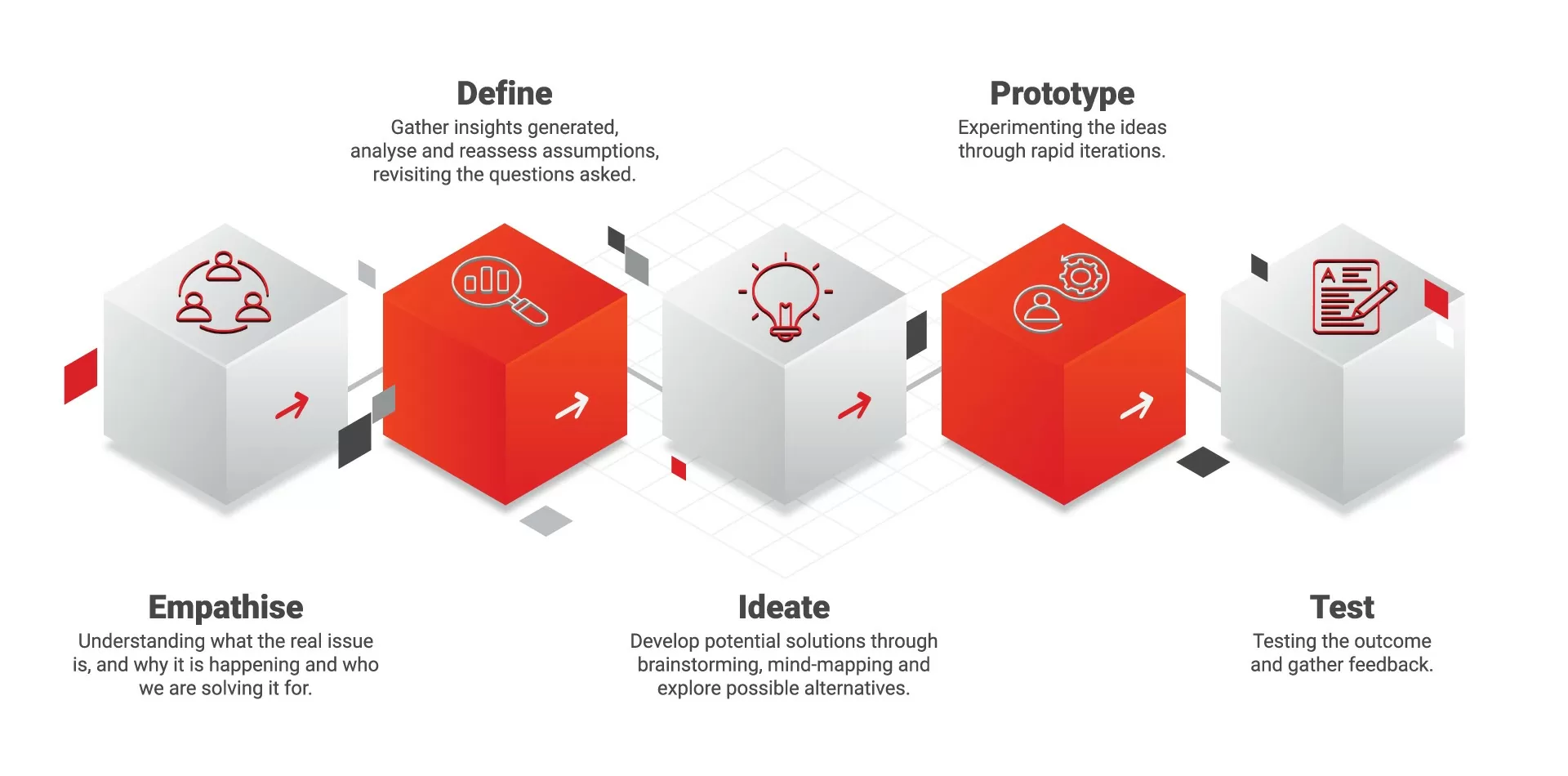Learning
Learning
by Design
by Design

The revolutionary approach to “Learning by Design” at XWA is an innovative pedagogy empowering students to prepare for the future. Here, they are equipped with skills and techniques that encourage creative problem-solving.
In the classroom, students are given the opportunity to use their imagination and hone problem-solving abilities while turning it into a fun and engaging experience. From introducing unconventional collaborations to simulating real-life scenarios, we are committed to our role as the School of the Future, guaranteeing students a unique discovery of cutting-edge, interdisciplinary learning.

What is Design Thinking?
Design thinking is a problem-solving and innovation methodology that focuses on understanding and addressing the needs and desires of end-users to create effective solutions. It is a human-centred approach that originated in the field of design but has since been widely adopted in various industries, including business, education, and healthcare. Design thinking typically involves the following key stages:

Design thinking is a leading topic in corporate professional development, with a focus on elevating the performance, productivity and problem-solving skills of an organisation’s workforce. Surprisingly, this crucial skill set was absent from our educational experiences when we, as parents, went to school.
Today, children have the unique opportunity to cultivate these skills from an early age. XWA’s Learning by Design programme will equip students with a versatile set of problem-solving and creative skills that are invaluable in a rapidly changing and complex world.
The Importance of Teaching Design Thinking in Schools
Design thinking is an essential skill for students to learn in school for several reasons:
Problem-solving: Design thinking is a structured approach to problem-solving that encourages students to define problems, explore potential solutions and test those solutions. This process helps students become better problem-solvers in various aspects of their lives.
Creativity and innovation: Design thinking promotes creative thinking and innovation. It encourages students to think outside the box and develop unique solutions to problems, fostering their creative abilities.
Empathy and understanding: Design thinking emphasises compassion by encouraging students to understand the needs and perspectives of the end users. This skill is valuable not only in design but also in fields like psychology, healthcare, and social sciences, where understanding people’s needs and experiences is crucial.
Collaboration: Design thinking often involves working in teams to solve complex problems. Learning to collaborate and communicate effectively with others is a vital skill for students to develop, as it’s valuable in virtually all aspects of life and work.

The Importance of Teaching Design Thinking in Schools
Design thinking is an essential skill for students to learn in school for several reasons:
Problem-solving: Design thinking is a structured approach to problem-solving that encourages students to define problems, explore potential solutions and test those solutions. This process helps students become better problem-solvers in various aspects of their lives.
Creativity and innovation: Design thinking promotes creative thinking and innovation. It encourages students to think outside the box and develop unique solutions to problems, fostering their creative abilities.
Empathy and understanding: Design thinking emphasises compassion by encouraging students to understand the needs and perspectives of the end users. This skill is valuable not only in design but also in fields like psychology, healthcare, and social sciences, where understanding people’s needs and experiences is crucial.
Collaboration: Design thinking often involves working in teams to solve complex problems. Learning to collaborate and communicate effectively with others is a vital skill for students to develop, as it’s valuable in virtually all aspects of life and work.
The Importance of Teaching Design Thinking in Schools
Design thinking is an essential skill for students to learn in school for several reasons:
Problem-solving: Design thinking is a structured approach to problem-solving that encourages students to define problems, explore potential solutions and test those solutions. This process helps students become better problem-solvers in various aspects of their lives.
Creativity and innovation: Design thinking promotes creative thinking and innovation. It encourages students to think outside the box and develop unique solutions to problems, fostering their creative abilities.
Empathy and understanding: Design thinking emphasises compassion by encouraging students to understand the needs and perspectives of the end users. This skill is valuable not only in design but also in fields like psychology, healthcare, and social sciences, where understanding people’s needs and experiences is crucial.
Collaboration: Design thinking often involves working in teams to solve complex problems. Learning to collaborate and communicate effectively with others is a vital skill for students to develop, as it’s valuable in virtually all aspects of life and work.


Critical thinking: Design thinking encourages critical thinking and evaluation of ideas. Students learn to assess the feasibility, viability and desirability of different solutions, honing their analytical skills.
Adaptability: In today’s ever-changing world, adaptability is a valuable skill. Design thinking teaches students to iterate on their solutions and be open to change and improvement, which is important in the rapidly evolving job market and society.
User-centred design: Understanding the importance of designing products, services and solutions with the end user in mind is a fundamental concept of design thinking. This user-centric approach is beneficial for students as they learn to create products and solutions that better meet the needs and preferences of their target audience.
Real-world applications: Design thinking has applications across various fields, from business and engineering to healthcare and education. By learning design thinking, students gain skills that can be applied to various real-world situations and future careers.
Problem ownership: Design thinking encourages individuals to take ownership of problems and actively seek solutions. This proactive mindset can empower students to become agents of change in their communities and beyond.
Personal growth: Beyond its practical benefits, design thinking can help students develop a growth mindset, where they are more open to learning from failure and seeing setbacks as opportunities for improvement.
If you are interested in finding out more about our Learning by Design programme, please do not hesitate to contact our Admissions Team today.

Critical thinking: Design thinking encourages critical thinking and evaluation of ideas. Students learn to assess the feasibility, viability and desirability of different solutions, honing their analytical skills.
Adaptability: In today’s ever-changing world, adaptability is a valuable skill. Design thinking teaches students to iterate on their solutions and be open to change and improvement, which is important in the rapidly evolving job market and society.
User-centred design: Understanding the importance of designing products, services and solutions with the end user in mind is a fundamental concept of design thinking. This user-centric approach is beneficial for students as they learn to create products and solutions that better meet the needs and preferences of their target audience.
Real-world applications: Design thinking has applications across various fields, from business and engineering to healthcare and education. By learning design thinking, students gain skills that can be applied to various real-world situations and future careers.
Problem ownership: Design thinking encourages individuals to take ownership of problems and actively seek solutions. This proactive mindset can empower students to become agents of change in their communities and beyond.
Personal growth: Beyond its practical benefits, design thinking can help students develop a growth mindset, where they are more open to learning from failure and seeing setbacks as opportunities for improvement.
If you are interested in finding out more about our Learning by Design programme, please do not hesitate to contact our Admissions Team today.
The Importance of Teaching Design Thinking in Schools
Critical thinking: Design thinking encourages critical thinking and evaluation of ideas. Students learn to assess the feasibility, viability and desirability of different solutions, honing their analytical skills.
Adaptability: In today’s ever-changing world, adaptability is a valuable skill. Design thinking teaches students to iterate on their solutions and be open to change and improvement, which is important in the rapidly evolving job market and society.
User-centred design: Understanding the importance of designing products, services and solutions with the end user in mind is a fundamental concept of design thinking. This user-centric approach is beneficial for students as they learn to create products and solutions that better meet the needs and preferences of their target audience.
Real-world applications: Design thinking has applications across various fields, from business and engineering to healthcare and education. By learning design thinking, students gain skills that can be applied to various real-world situations and future careers.
Problem ownership: Design thinking encourages individuals to take ownership of problems and actively seek solutions. This proactive mindset can empower students to become agents of change in their communities and beyond.
Personal growth: Beyond its practical benefits, design thinking can help students develop a growth mindset, where they are more open to learning from failure and seeing setbacks as opportunities for improvement.
If you are interested in finding out more about our Learning by Design programme, please do not hesitate to contact our Admissions Team today.






PEI registration number: 200803726H,
19 March 2025 to 18 March 2029







.jpg)